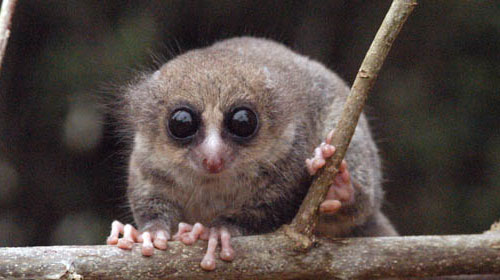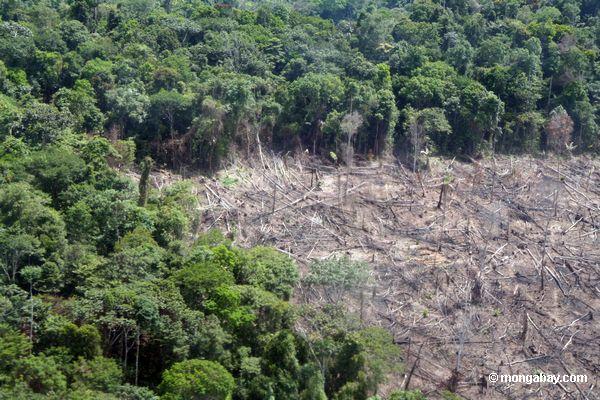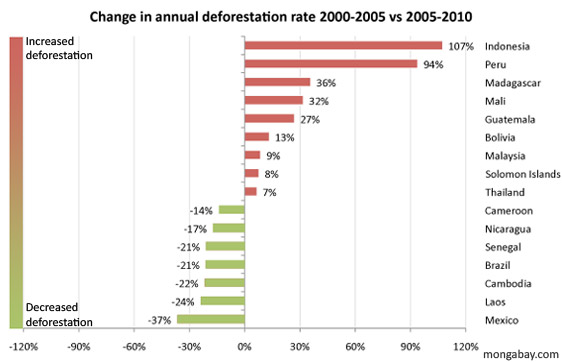| Satellite Image of Madagascar (2) |
 |
| Hairy-eared Dwarf Lemur (it has only been found so-far in eastern Madagascar) (24) |
Madagascar has lost more than about 90 percent of its forest cover. The rainforests in the eastern and southeastern part of the island are some of the hardest hit. Historically, the tropical rainforests of Madagascar were a lot larger. There are varying estimates on the extent of the deforestation of the tropical rainforests but the rainforests covered about three times or more of the land than today's forests. Historically, the rainforests in the east, and even other forests and vegetation throughout the rest of the island, covered much of the island. At one point, forests "blanketed the eastern third of the island"(3). The forests extended "continuously through significant elevational gradients starting at sea-level"(4). The historical layout of the rainforests differ from today where the remaining strands of this forest are isolated from each other and are hardly connected in one mass. The trees and vegetation in the old rainforests of Madagascar were more densely packed, green, and had more animal, reptiles, amphibians, and insects.
 |
| (5) |
 |
| What Madagascar's rainforests would've historically looked like (6) |
 |
| What Madagascar's rainforests look like today (7) |
Tavy, or slash and burn agriculture, is used to turn tropical rainforests in eastern Madagascar into rice fields. An acre or more of rainforest is usually cut and then burned to create land with fertile soil so that rice can be planted. This process is repeated a couple more times until there are no longer any nutrients in the soil and the soil erodes or the land is newly inhabited by grass and weeds.(11) Logging for timber is another bad human impact on the eastern rainforest. Due to the high value of Malagasy hardwoods, which include ebony and rosewood "which may fetch $2,000 a ton in international markets", illegal logging of rainforest timber is a huge problem.(3) People also use the rainforest for fuelwood and charcoal. People need these things to subsist and cook food.(12) In addition to cooking, large quantities of wood are used to heat the home and provide a light source at night because there is a lack of electricity in rural areas and other poverty-stricken areas.(13) People clear the forests to make grazing and ranching land for their cattle and other livestock. Urban development of structures due to population growth and road clearance for access to timber are also negative human impacts on the eastern tropical rainforests of Madagascar that contribute to its deforestation.
 |
| Clear-cutting for slash and burn agriculture (18) |
 |
| Chess pieces made from rosewood which are found in tropical regions of Madagascar (19) |
 |
| Fuelwood from cut-down trees being sold in Madagascar (20) |
 |
| Cattle grazing on land that was cleared for this purpose (21) |
The impacts that humans have on the rainforests in Madagascar are due to the economical and subsistence-related benefits the people gain from the ecosystem. However, on a more positive note, the ecosystem truly benefits the people of Madagascar by producing oxygen and removing carbon dioxide from the atmosphere. Also, there are many useful plants found in the eastern rainforests that benefit humans. Much of the tropical plants have anti-carcinogenic properties to it that can be used to be make medicine.(14)
 |
| Ranomafana National Park's entrance (22) |
In order to protect and conserve the remaining tropical rainforests in eastern Madagascar, the government under President Marc Ravalomanana worked to expand the area of protection for its forest, keep much of its endangered wood from the tropical rainforests off of the markets, make logging in some parts of the rainforests illegal, and expand eco-tourism in areas near and in the tropical rainforests so that the forests could be protected and the locals there wouldn't have to resort to tavy to find income. Much of the large blocks of remaining rainforests are found in national parks like: Masoala National Park, Ranomafana National Park, Mananara Biosphere Reserve, which includes the Verezanantsoro National Park, Ambatovaky Special Reserve, and Zahamena Integral Nature Reserve and National Park. The Ranomafana National Park was established in 1991 and covers parts of the lowland rainforests in the east. Despite these national parks and reserves and other efforts, the likely future prospects for this ecosystem are really dim. After some of their inception in the 1920's by the French colonial rule, national parks and reserves still fail to protect large areas of lowland rainforests that occur outside of the protected areas Only about 3 percent of the land area in Madagascar is protected.(14) The status of protected areas isn't good because national parks, reserves, and special reserves aren't doing a good job of protecting the remaining tropical rainforests because of a "lack of logistic and financial resources, poorly marked and managed boundaries, and inadequately trained staff and increasing pressure from farming communities around the reserves"(4). As the data graph below shows, due to the reasons listed above, annual deforestation rate in 2005-2010, as compared to 2000-2005, increased by 36 percent. This shows that Madagascar isn't move in the right direction in protecting its forests and that the future prospects for the rainforests, both protected and unprotected, are grim.
 |
| (15) |
The bad future prospects for Madagascar's tropical rainforests and the areas that they are protected in are also made worse by the new transitional government that control after President Ravalomanana was ousted from office. The new government is "failing to "uphold commitments to protect national forests. After this take over, illegal logging escalated in many of the island's protected area"(13). In discussing further issues with protection of forests, Frank Hawkins, vice president of Conservation International's Africa program, said, "Park staff and management authorities have been deprived of the resources and mechanisms they need to prevent illegal logging"(16). The new transitional government even gave permission to 13 operators to each export 25 containers of ebony and rosewood. If this continues, communities around the rainforests will have to go back to their tavy agriculture because loss of forests takes away from the revenue made from tourism and other things. In the future, this ecosystem is likely to become further damaged and deforested due to poor government protection and maintenance of forests, current agricultural practices, and an increasing population. Most of the rainforest losses have occurred in the last 70 years and the local people are one of the major causes of this.With more effort from the government and its people and funding, the future of this ecosystem could change from very bad, which it is looking to be, to good.
Many things can be done to change the negative future of the tropical rainforests in eastern Madagascar and improve human impacts on that ecosystem. First, new agricultural techniques can be promoted and used to replace old subsistence agriculture which includes tavy. Savoka gardens is one agricultural idea that is eco-friendly. Savoka gardens are a selected succession of plants and trees that are planted on fallow tavy plots in order to re-enrich the soil and provide a steady supply of food crops and other products. This is a good idea because it maintains forest systems and soil so that plants would be able to grow and erosion wouldn't occur.(17) Palm trees can be part of a savoka garden. They thrive on nutrient-poor soil and put nutrients into the soil, prevent erosion, and the oil from the tree can be sold to create income.(14) Second, ecotourism can be further encouraged and better managed to save rainforests from deforestation. Ecotourism is capable of generating a lot of money for the government and the local people who are hired to work in tourism. Money through tourism means that the locals will have work so they will be discouraged from cutting down trees to subsist and the government will be more willing to conserve the rainforests because they bring in revenue. Third, the government can establish more national parks to increase the area of rainforests that are protected. If protected areas of rainforests can be developed in a way that produces revenues for the local people, the creation of more national parks and reserves should be beneficial to the people and the ecosystem. Fourth, the government can better educate the local people on the environmental dangers of deforesting tropical rainforests and teach them sustainable practices that can still provide income. Sixth, the government of Madagascar can educate more people to become scientists and researchers that are able to study the hidden medical benefits in tropical plants so that the rainforests are conserved to protect these healing plants. Lastly, "debt-swapping" can be done to prevent deforestation of tropical rainforests. Debt-swapping is an economic arrangement in which developed countries agree to get rid of the debts of the developing country by "allowing the debts to be purchased at a fraction of their face value and then used to finance conservation work"(14).
 |
| Advertisement of eco-tourism in Madagascar (23) |
The tropical rainforests of eastern Madagascar is home to many different endemic plant and animal species. Due to human impact, the status of this ecosystem, including the parts that are protected, is bad. However, the government and people can still take steps to create a balance between them and the ecosystem.
Reference List
1. "Madagascar Lowland Forests." Encyclopedia of Earth. Web. 25 Nov. 2011. <http://www.eoearth.org/article/Madagascar_lowland_forests>.
2. "Madagascar Satellite Image - Mapsof.net." A Collection of World, Country and City Maps - Mapsof.net. Web. 25 Nov. 2011. <http://mapsof.net/map/madagascar-satellite-image>."Madagascar Satellite Image - Mapsof.net." A Collection of World, Country and City Maps - Mapsof.net. Web. 25 Nov. 2011. <http://mapsof.net/map/madagascar-satellite-image>.
3. "Madagascar: Environmental Profile." Rainforests. Web. 25 Nov. 2011. <http://rainforests.mongabay.com/20madagascar.htm>.
4. "Terrestrial Ecoregions -- Madagascar Lowland Forests (AT0117)." Wildlife Conservation, Endangered Species Conservation. Web. 26 Nov. 2011. <http://www.worldwildlife.org/wildworld/profiles/terrestrial/at/at0117_full.html>.
5. "Madagascar Deforestation Article | The Conservation Report." The Conservation Report | Tracking News regarding Conservation, the Environment, Energy, Politics, and Technology. Web. 26 Nov. 2011. <http://conservationreport.com/tag/madagascar-deforestation-article/>.
6. Broek, Rob. Tropical Rainforest in Madagascar. Political and Social Chaos and a Lack of International Protections Have Put Several Species of Rosewood Trees in Madagascar in Danger of Becoming Extinct from Illegal Logging. Photograph. IStockphoto.
7. Talbot, Jonathon. Rain Forest Destruction, Madagascar. 2003. Photograph. World Resources Institute.
8. "Deforestation In Madagascar." Page Has Moved. Web. 24 Nov. 2011. <http://www1.american.edu/ted/MADAGAS.HTM>.
9. Sponsel, Leslie E., Thomas N. Headland, and Robert Converse. Bailey. "Chapter 13." Tropical Deforestation: the Human Dimension. New York: Columbia UP, 1996. 298. Print.
10. Ferguson, Barry. "REDD in Madagascar: An Overview of Progress." Madagascar Conservation & Development 4.2 (2009). Web. 24 Nov. 2011.
11. "Threats to Madagascar's Environment." Madagascar. Web. 26 Nov. 2011. <http://www.wildmadagascar.org/conservation/threats.html>.
12. "Deforestation in Madagascar." College of Natural Resources and Environment | Virginia Tech. Web. 26 Nov. 2011. <http://cnre.vt.edu/lsg/GEOG3104S10Web/Group1/Caitlin/Introduction.html>.
13. "Deforestation in Madagascar." NC State: WWW4 Server. Web. 26 Nov. 2011. <http://www4.ncsu.edu/~tlbolton/world_forestry/>.
14. "Deforestation of Tropical Rainforests - A Case Study of Madagascar." Geocases1.co.uk. Web. 24 Nov. 2011. <http://www.geocases1.co.uk/printable/Deforestation%20of%20TRF%20a%20case%20study%20of%20Madagascar.htm>.
15. "Rainforest Loss Slows." Conservation and Environmental Science News. Web. 26 Nov. 2011. <http://news.mongabay.com/2010/1006-fao_forest_cover.html>.
16. "Political Unrest Portends Ecological Ruin in Madagascar." Worldwatch Institute. Web. 26 Nov. 2011. <http://www.worldwatch.org/node/6283>.
17. "Making Conservation Work in." Madagascar. Web. 25 Nov. 2011. <http://www.wildmadagascar.org/conservation/saving.html>.
18. "Overhead View of Clear-cutting for Slash-and-burn Agriculture in the Peruvian Amazon." World Travel Photos - Mongabay.com. Web. 27 Nov. 2011. <http://travel.mongabay.com/pix/peru/aerial-rainforest-Flight_1022_1555.html>.
19. "File:RosewoodPieces.jpg." Wikipedia, the Free Encyclopedia. Web. 27 Nov. 2011. <http://en.wikipedia.org/wiki/File:RosewoodPieces.jpg>.
20. "Madagascar Is a Biological Marvel but It Faces Grave Threats | Adventures in Conservation." RARE Conservation. Web. 27 Nov. 2011. <http://www.rareconservation.org/blog/2010/05/13/madagascar-is-a-biological-marvel-but-it-faces-grave-threats/>.
21. "Grazing Zebu Cattle." World Travel Photos - Mongabay.com. Web. 27 Nov. 2011. <http://travel.mongabay.com/madagascar/images/madagascar_6867.html>.
22. "File:Sign At Entrance To Ranomafana National Park.jpg." Wikipedia, the Free Encyclopedia. Web. 27 Nov. 2011. <http://en.wikipedia.org/wiki/File:Sign_At_Entrance_To_Ranomafana_National_Park.jpg>.
23. Madagascar Tour Guide | English Speaking Local Tour Guide Company in Madagascar. Web. 27 Nov. 2011. <http://www.madagascar-tour-guide.com/>.
24. "Hairy-eared Dwarf Lemur - Characteristics, Habitat & Breeding - Endangered Species." It's Nature - News, Videos & Pictures From the Natural World. Web. 27 Nov. 2011. <http://www.itsnature.org/endangered/hairy-eared-dwarf-lemur/>.
18. "Overhead View of Clear-cutting for Slash-and-burn Agriculture in the Peruvian Amazon." World Travel Photos - Mongabay.com. Web. 27 Nov. 2011. <http://travel.mongabay.com/pix/peru/aerial-rainforest-Flight_1022_1555.html>.
19. "File:RosewoodPieces.jpg." Wikipedia, the Free Encyclopedia. Web. 27 Nov. 2011. <http://en.wikipedia.org/wiki/File:RosewoodPieces.jpg>.
20. "Madagascar Is a Biological Marvel but It Faces Grave Threats | Adventures in Conservation." RARE Conservation. Web. 27 Nov. 2011. <http://www.rareconservation.org/blog/2010/05/13/madagascar-is-a-biological-marvel-but-it-faces-grave-threats/>.
21. "Grazing Zebu Cattle." World Travel Photos - Mongabay.com. Web. 27 Nov. 2011. <http://travel.mongabay.com/madagascar/images/madagascar_6867.html>.
22. "File:Sign At Entrance To Ranomafana National Park.jpg." Wikipedia, the Free Encyclopedia. Web. 27 Nov. 2011. <http://en.wikipedia.org/wiki/File:Sign_At_Entrance_To_Ranomafana_National_Park.jpg>.
23. Madagascar Tour Guide | English Speaking Local Tour Guide Company in Madagascar. Web. 27 Nov. 2011. <http://www.madagascar-tour-guide.com/>.
24. "Hairy-eared Dwarf Lemur - Characteristics, Habitat & Breeding - Endangered Species." It's Nature - News, Videos & Pictures From the Natural World. Web. 27 Nov. 2011. <http://www.itsnature.org/endangered/hairy-eared-dwarf-lemur/>.